The journey to Blackpool didn't go quite to plan so 'part 1' only describes getting there. Much later, I added 'part 2' here describing my (literally) pedestrian explorations in Blackpool and Fleetwood.
Click on any image below for 'uncropped' view, or search 'My pictures' to view or download in various sizes.
By train to Crewe
Relying on the local bus to reach the station at Wolverhampton, the earliest train I could catch north was the 07:54 London Midland Class 350 Electric Multiple Unit to Liverpool. This took me as far as Crewe. With stops at Penkridge and Stafford, this is allowed 36 minutes to Crewe, six minutes longer than the later Virgin 'Pendolino' at 08:37 from Wolverhampton which is non-stop. With a slack through Norton Bridge (probably because of the ongoing project to construct a flyover junction here) and the seemingly-obligatory stop at Crewe South Junction waiting for signals, we may have been a couple of minutes late arriving.
Whilst we waited for the signal, I mused about the long-gone mechanical signal box at Basford Wood, in between Basford Hall Junction (still, amazingly, a signal box) and Crewe South Junction. Basford Wood controlled a facing connection from the Down Slow to the Down Goods Line and connections from the Up Goods Line (and the Carriage Shed) to either the Up Fast or Up Slow. The trailing connection to the Up Fast remains, controlled by a Ground Frame.
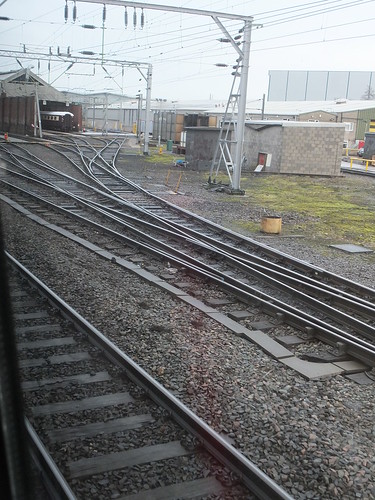
2014 View of the former Carriage Shed on the Up side, latterly the LNWR depot, from the south. Note the two tandem turnouts ('triple leads').
The facing connection from the Down Slow was removed but track of the former Down Goods line remains, still featuring the original bullhead rail. A buffer stop has been placed partway along the line and north of this buffer stop is now called a Down Siding, with a trailing connection back to the Down Slow at Crewe South Junction. I don't think the siding gets much use but I spotted a Virgin-liveried passenger coach parked there a while ago.
 Crewe: South Junction: Stop block on former Down Loop.
Crewe: South Junction: Stop block on former Down Loop.
The derelict structure of Crewe South Junction signal box remains, as a permanent rebuke to Network Rail. As a reinforced-concrete 'Air Raid Precautions' design, I suppose it's regarded as too expensive to remove, like the numerous concrete World War II fortifications which still litter the country. There's a bit more about Crewe South Junction signal box here.
On arrival at Crewe, I had to wait for the later 08:37 from Wolverhampton to catch up with me. This train was due to go forward at 09:09, arriving Preston at 09:52, giving me around half an hour to leave the station and explore.
Crewe Signalling Centre
Crewe Signalling Centre was supposed to be a 'temporary' affair, presumably accounting for its appearance which I always think looks like a B & Q warehouse. Hiding behind a tall galvanised fence on the site of Crewe North locomotive shed, I've never been able to get a reasonable picture from the railway so I thought I might just have time to leave the station and get a closer look from the nearby housing estate. As I got nearer the railway, there was a forest of standard galvanised railway fencing extending in all directions, marking out the railway boundary, the public car park and the railway staff car park. As I was about to give up, I came upon a spot when one fence panel had been neatly removed and laid to one side. I don't know why, but it could have been to provide an unofficial walking route to the staff car park.
Passing through the opening, I came to the rather forbidding compound of Crewe Signalling Centre, with its extra-tall barbed-wire topped fence, numerous lighting standards with high-intensity lighting fittings and tall poles with surveillance cameras. To prevent 'ram-raiding', a regular series of tough-looking bollards had been set up all around the periphery of the compound inside the fence. Entrance to the compound was via a serious-looking automatic gate with an intercom and card reader. There was space inside the compound for vehicle parking and the end of the building near the parking area was protected by 'Armco' barriers. I concluded this was a defence against employees' poor driving, rather than against 'enemy action'. I managed a few pictures which don't add a lot but do show two Relocatable Equipment Buildings (REBs) in the compound, one provided with a fire suppression system, judging by the external warnings (Since fire suppression systems seek to extinguish or limit fire by the exclusion of oxygen, it's essential that the systems be isolated before staff carry out work in these areas).
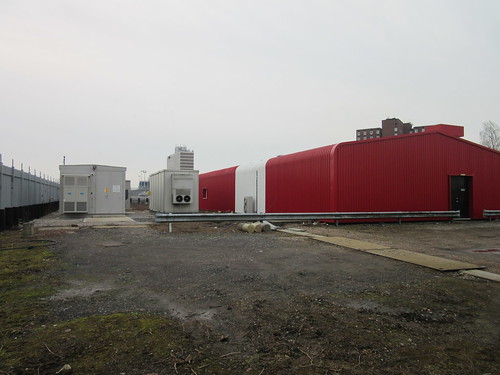 Crewe Signalling Centre (R), with two Relocatable Equipment Buildings (L).
Crewe Signalling Centre (R), with two Relocatable Equipment Buildings (L).
Before returning to the station, I took a picture of the old Cable Bridge which runs across Crewe North Junction and a much newer Cable Bridge I'd not really noticed before (although it shows up on a number of my pictures).
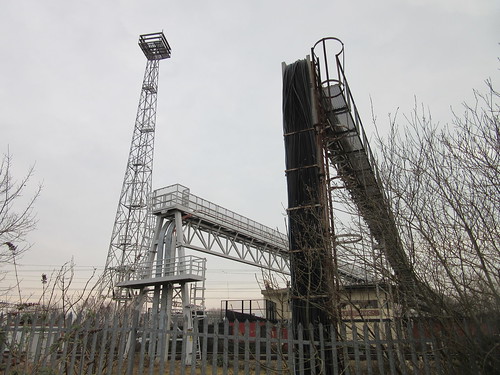 Crewe North Junction: Cable Bridges - New (L), Old (R). The preserved former Crewe North Junction signal box is in the background.
Crewe North Junction: Cable Bridges - New (L), Old (R). The preserved former Crewe North Junction signal box is in the background.
Bewilderment at Crewe
Back at the station, the departure displays suggested my train was already in platform 11 and, indeed, a 'Pendolino' was standing there, with doors open. But there seemed a lot of people hanging about on the platform, rather than boarding. There was an announcement on the public address as I made my way to the platform but coverage at Crewe is rather patchy and I couldn't make it out. The electronic displays mounted in the slidin-plug doors of the train gave the destination as Liverpool. I heard part of an announcement by the Conductor/Guard over the train public address talking about cancellation of the train which would now return to London. If passengers wanted to "abandon their journey" and go back, they were told not to worry about ticket validity. Clearly something was badly amiss. The platform display had changed to show my train as 'Delayed'. The station public address was silent and the platform staff had disappeared. The platform enquiry office had two harrassed looking staff slowing working through a long queue of worried passengers which snaked all the way round the outside of the building. A station cleaner I knew believed the emergency services were dealing with a incident to the north of Crewe.
Trains did not appear to be running on the Manchester line because of planned engineering work. There was one departure shown to Manchester Oxford Road only, but it suddenly got cancelled according to the platform display, without explanation. It was only later I realised that, denied the normal route from Crewe, this train had been scheduled to travel via Warrington and join the Liverpool and Manchester line to Oxford Road, hence the lack of intermediate stops.
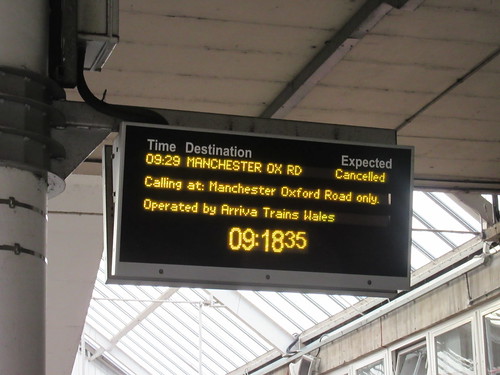 Suddenly cancelled Manchester service.
Suddenly cancelled Manchester service.
I realised that Liverpool could be reached by taking a Chester train and then the 'Merseyrail' electrics to Liverpool (as I'd done previously, for instance as described in Birkenhead and New Brighton by train (Part 1)). I vaguely wondered whether to attempt Liverpool this way but, by the time I'd reached the platform, the 2-coach diesel multiple unit was absolutely packed, with a crowd of disconsolate people still on the platform, faced with waiting for a later service.
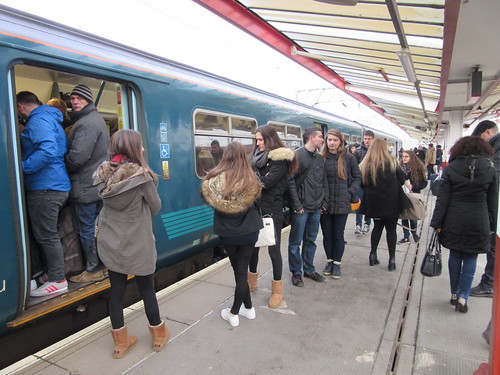 Overloaded Chester service.
Overloaded Chester service.
Eventually a couple of Virgin staff appeared on the platform and attempted to give some information to the waiting throng. There had apparently been a fatality at Acton Bridge which the emergency services were attending and there would be no trains to or from the north until this was dealt with. One member of Virgin staff acquitted himself, I thought, very well remaining cheerful under the barrage of questioning and trying to make helpful suggestions as to how people might continue their travel or return to their starting point. A train had hit and killed a person at Acton Bridge, he said, adding that Emergency Services are allowed to close a line, in the first instance, for up to three hours but that if it's a straightforward suicide the closure can be as short as one hour.

Bewilderment at Crewe: Virgin staff try to help.
I was surprised that there wasn't chaos, there wasn't apparent anger, just resignation and bewilderment. From time to time, the departure displays would change, replacing one set of incorrect information with a different set of wrong information. Nothing arrived from the north, but various trains arrived from the south and disgorged their passengers. The strategy appeared to be to turn these trains round and send them back. With the unknown delay in getting a train to my intended destination, I wondered whether to head back home.
The 10:02 London Midland Service to Euston via Stoke would have taken me at least as far as Stafford and, since this train was already standing in platform 3 Bay, staff were enthusiastically directing Southbound passengers to it. The train was already fairly full but I couldn't see a Guard or a Driver so I hovered near the open door. Just after ten o'clock, the signal cleared, so I wondered if I was wrong but, after a couple of minutes inactivity, a member of station staff came to find out what the delay was. "I don't think we've got a crew" I said, as he went to check the driver's cab. A minute later, the signal went back to red so, letting a nearby passenger know, I 'bailed out'. The station staff didn't update the waiting passengers and, of course, without a driver or guard, there was no on-train announcement but by the time I'd got level with the nearest platform departure display, it had changed from '10:02 Euston' a few minutes earlier to '11:02 Euston'.
Whilst this little fiasco was being played out, I'd noticed a 'Class 350' arrive from the south and, unusually, run into the little-used platform 12. A few minutes later, a second 'Class 350' followed, also into platform 12. I pointed out to the Virgin staff that their assurances on the 10:02 had not worked out but they were equally confident that the train "already waiting in platform 12" would soon be heading south. The 'Pendolino' which had been occupying platform 11 departed south for Milton Keynes and Euston and the platform departure display immediately changed to show '10:09 Preston'. Very mistrustful of this information, I started to make my way to platform 12 for the southbound train when a non-stop 'Pendolino' roared through on the Down Through line. Does that mean, I wondered, that the line has been re-opened? I returned to platform 11 and, about ten minutes late, what was to be the 10:09 Preston pulled into the crowded platform. I boarded and didn't even attempt to locate a seat on the packed train but located myself by the small window of the left-side sliding-plug automatic door at the rear of the quiet coach, resigned to standing to Preston.
 Bewilderment at Crewe: Arrival of 10:09 to Preston.
Bewilderment at Crewe: Arrival of 10:09 to Preston.
The tragic cause of all this was probably not the fault of any of the many railway organisations involved but I do blame them all for the inept handling after the cause and, particularly, for the lack of accurate and timely information to the bewildered passengers.
Continuing to Blackpool
We made reasonable speed as we left Crewe. Beyond Hartford, I noticed a 'Class 350' stationary on the Down Slow, just before the Down Slow and Down Fast converge into a single Down line through Acton Bridge station as far as Weaver Junction. Later, I realised that this was very probably the 07:54 from Wolverhampton to Liverpool I'd travelled on as far as Crewe. This should have passed through Acton Bridge at about 08:45 so it was most likely the train involved in the fatality. Our speed was slightly reduced through Acton Bridge, then we sped through Weaver Junction, where the Liverpool Line diverges to the left.
We were soon approaching the Manchester Ship Canal. There are some historic disused railway bridges on the Up side I've not yet managed to photograph. The original line ran at a lower level under these bridges but, to obtain the necessary clearance for ships when the Manchester Ship Canal was built between 1887 and 1894, a deviation line was constructed to the west with a rising gradient leading to the bridge. I discussed a similar deviation required by the construction of the Manchester Ship Canal further east, at Irlam, in the post By Train to Irlam. As we rattled across the ship canal bridge, I could see Fiddler's Ferry coal fired power station, recently in the news as the owners, SSE plc, announced the intended closure of 3 of the 4 generating units here in April 2016.
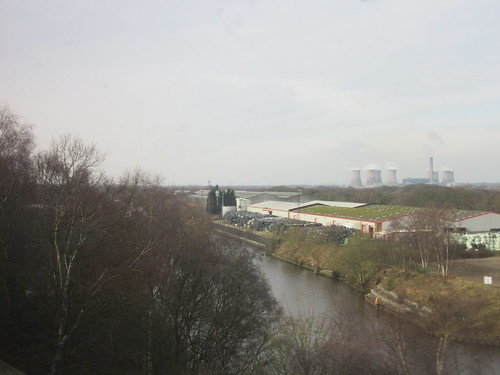 Crossing the Manchester Ship Canal at Acton Grange, with Fiddler's Ferry Power Station in the background.
Crossing the Manchester Ship Canal at Acton Grange, with Fiddler's Ferry Power Station in the background.
Our stop at Warrington Bank Quay was a little longer than normal, because of the number of people getting off and on. Then, we were off again. A few minutes after leaving Warrington, near Newton-le-Willows, we entered a sandstone cutting to dive under the Liverpool and Manchester Railway, 'the first inter-city railway in the world'. I've not yet managed a reasonable picture when passing through the cutting but the picture below was taken when passing over the top on 27th July 2013 when I was off to the Museum of Science and Industry in Manchester at the end of a rather crowded few days described in the post A Busy Week.
 A view taken in 2013 from the Liverpool and Manchester Railway, showing the West Coast Main Line passing under in a sandstone cutting near Newton-le-Willows.
A view taken in 2013 from the Liverpool and Manchester Railway, showing the West Coast Main Line passing under in a sandstone cutting near Newton-le-Willows.
Our next stop was Wigan North Western and, as we left, we passed over the former Lancashire and Yorkshire Railway, with its diverging routes from Wigan Wallgate to Kirkby (change for Liverpool) on the left and Southport on the right. A trip including both of these routes is described in Day Trip to Southport and Liverpool (Part 1) and Day Trip to Southport and Liverpool (Part 2).
 Wigan Wallgate Junction.
Wigan Wallgate Junction.
We made a fairly spirited run to Preston but were still about as late arriving as the departure from Crewe had been. I quickly made my way to platform 1 for the next Blackpool service - a Northern Rail train stopping at Kirkham, Poulton-le-Fylde, Layton and Blackpool North.
Whilst I waited with the large crowd on the platform for the arrival of the Blackpool train, a Northern Rail single-car 'Class 153' service from Ormskirk arrived on the other side of the island platform, platform 2, discharged its passengers and quickly loaded up, ready to go back to Ormskirk. I described using this line in the post Preston to Liverpool by Rail. My train arrived a few minutes late, one of the dreadful 2-car 'Class 142' units, first introduced in 1985, which still live on although they should never have been foist on an unsuspecting public in the first place. I was lucky in getting a seat for the journey - quite a number of passengers were forced to stand. With 4-wheel, long-wheelbase coaches we 'lolloped' along to Blackpool in what has been politely described as 'nodding donkey' fashion (I'm sure less-complimentary descriptions must exist). With such a crowded train, I couldn't see too much on the journey. I was just glad to arrive in Blackpool at around ten to twelve, when earlier it seemed doubtful I'd make it at all.
Book References
[ 1] ‘British Railways Layout Plans of the 1950’s - Volume 1: ex-LNWR main line, Euston to Crewe’ (Signalling Record Society) ISBN: 1 873228 00 7.
[ 2] ‘British Railways Layout Plans of the 1950’s – Volume 5: ex-Lancashire & Yorkshire Railway Lines in West Lancashire’ (Signalling Record Society) ISBN: 1 873228 04 X.
[ 3] ‘British Railways Layout Plans of the 1950’s – Volume 6: West Coast Main Line (Euxton Junction to Mossband) and Branches’ (Signalling Record Society) ISBN: 1 873228 00 7.
[ 4] ‘British Railways Layout Plans of the 1950’s - Volume 9: LNW Lines Crewe to Euxton Junction, Liverpool to Manchester (and associated branches)’ (Signalling Record Society) ISBN: 1 873228 11 2.
[ 5] ‘Railway Track Diagrams Book 4: Midlands & North West’ (TRACKmaps: 4th edition) ISBN 978-0-9549866-7-4.
[ 6] ‘Along LMS Routes’ by Bill Hudson, Volume 1 Central & Western Divisions (Headstock Publications) ISBN 0 9512793 4 3.
The posts Railways around Blackpool and Railways around Preston list further books.
Related articles in this blog
Halfex to Blackpool.
A Trip to the Seaside.
Railways around Blackpool.
Railways around Preston.
Wolverhampton to Preston by rail.
Return to Blackpool and Fleetwood (part 2).
My pictures
Stafford Area rail.
Crewe Area rail.
Warrington Area rail.
Railways around Preston.
Blackpool's Railways.
